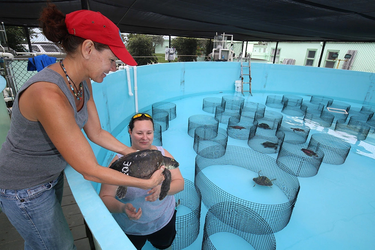‘Bubble Butt’ has died at 35. That name sent him to a Florida Keys hospital years ago
Bubble Butt, a green sea turtle who found fame after he survived a 1989 boat strike, died at a turtle hospital in the Florida Keys.
He was about 35 years old and known across the world for his resilience, his personality — and that name.
The cause of death is likely connected to the spinal injury he suffered from the boat strike, said Bette Zirkelbach, manager of the Turtle Hospital in the Middle Keys city of Marathon.
“He lived longer than anyone expected him to live,” Zirkelbach said Friday. “He was the most popular turtle we had.”
Bubble Butt, who was rescued from Long Key, had fans everywhere. Visitors would ask to see him. As of Friday afternoon, more than 14,000 people had reacted to his obituary posted on the hospital’s Facebook page.
Commenters recalled how people met Bubble Butt over the years and thanked the Turtle Hospital for making it possible for him to live his best turtle life.
“You’ve earned your peace in the big ocean in heaven where you will swim in new life with no threats, only love,” one post said.
But the death still stings for those who cared for and visited him.
“You get very attached,” Zirkelbach said. “After a while, you think you can keep them all alive. Nothing lives forever.”
Days before he died on April 23, Bubble Butt underwent a 12-hour surgery at the hospital, which had been his home since March 25, 1989.
It’s formally called “positive buoyancy disorder,” which leaves turtles permanently stuck floating on top of the water and unable to dive for food. They can starve in the wild.
Too much buoyancy, or a “bubble butt,” can result from a spinal injury.
The force of a boat strike can damage a turtle’s shell, which is bone, along with the keratin layer on the shell’s outside, according to the Turtle Hospital. The damage can run so deep that it affects internal organs and the spine. Neurological problems arise and severed nerves contribute to the ailment.
Bubble Butt the turtle was the first documented case of the disorder at the Turtle Hospital.
The hospital is home to other “bubble butts,” but its namesake was the original. But Bubble Butt couldn’t be fixed for good or sent back to the ocean. The disorder can’t be remedied with medication or surgery.
At the hospital he was the first sea turtle fitted with lead weights to his shell. This allows a turtle to submerge, but they would eventually fall off in the wild when a turtle sheds that keratin layer.
So Bubble Butt became the Turtle Hospital’s longest resident.
His home was a 160,000-gallon tidal pool where, as the hospital put it in his obituary, he took his job seriously as king of the pool and “sea turtle ambassador extraordinaire.”
Bubble Butt never missed an opportunity to surface and greet his guests, the obituary says. He also loved romaine lettuce, green peppers and the squid that contained his vitamins.
“His love of food and attention was only surpassed by his love for the ‘ladies’ in the tidal pool,” the hospital wrote. “Bubble Butt would show them affection that earned him his own 30,000-gallon tank during sea turtle mating season.”
Bubble Butt had a compelling survivor’s tale that brought attention to the impact humans can have on a threatened species, the hospital said. He taught people about the damage boat strikes can leave. He was an inspiration to survivors everywhere.
Bubble Butt is survived by his pool mates Rebel, Bender, Montel and April.
“Those we have loved shall never truly fade,” the Turtle Hospital wrote. “Bubble Butt will live in our hearts forever.”
Bubble Butt, a green sea turtle who found fame after he survived a 1989 boat strike, died at a turtle hospital in the Florida Keys.
He was about 35 years old and known across the world for his resilience, his personality — and that name.
The cause of death is likely connected to the spinal injury he suffered from the boat strike, said Bette Zirkelbach, manager of the Turtle Hospital in the Middle Keys city of Marathon.
“He lived longer than anyone expected him to live,” Zirkelbach said Friday. “He was the most popular turtle we had.”
Bubble Butt, who was rescued from Long Key, had fans everywhere. Visitors would ask to see him. As of Friday afternoon, more than 14,000 people had reacted to his obituary posted on the hospital’s Facebook page.
Commenters recalled how people met Bubble Butt over the years and thanked the Turtle Hospital for making it possible for him to live his best turtle life.
“You’ve earned your peace in the big ocean in heaven where you will swim in new life with no threats, only love,” one post said.
But the death still stings for those who cared for and visited him.
“You get very attached,” Zirkelbach said. “After a while, you think you can keep them all alive. Nothing lives forever.”
Days before he died on April 23, Bubble Butt underwent a 12-hour surgery at the hospital, which had been his home since March 25, 1989.
What ‘Bubble Butt’ means
“Bubble Butt” may have a silly ring to it, but it’s a grave condition.It’s formally called “positive buoyancy disorder,” which leaves turtles permanently stuck floating on top of the water and unable to dive for food. They can starve in the wild.
Too much buoyancy, or a “bubble butt,” can result from a spinal injury.
The force of a boat strike can damage a turtle’s shell, which is bone, along with the keratin layer on the shell’s outside, according to the Turtle Hospital. The damage can run so deep that it affects internal organs and the spine. Neurological problems arise and severed nerves contribute to the ailment.
Bubble Butt the turtle was the first documented case of the disorder at the Turtle Hospital.
The hospital is home to other “bubble butts,” but its namesake was the original. But Bubble Butt couldn’t be fixed for good or sent back to the ocean. The disorder can’t be remedied with medication or surgery.
At the hospital he was the first sea turtle fitted with lead weights to his shell. This allows a turtle to submerge, but they would eventually fall off in the wild when a turtle sheds that keratin layer.
So Bubble Butt became the Turtle Hospital’s longest resident.
His home was a 160,000-gallon tidal pool where, as the hospital put it in his obituary, he took his job seriously as king of the pool and “sea turtle ambassador extraordinaire.”
Bubble Butt never missed an opportunity to surface and greet his guests, the obituary says. He also loved romaine lettuce, green peppers and the squid that contained his vitamins.
“His love of food and attention was only surpassed by his love for the ‘ladies’ in the tidal pool,” the hospital wrote. “Bubble Butt would show them affection that earned him his own 30,000-gallon tank during sea turtle mating season.”
Bubble Butt had a compelling survivor’s tale that brought attention to the impact humans can have on a threatened species, the hospital said. He taught people about the damage boat strikes can leave. He was an inspiration to survivors everywhere.
Bubble Butt is survived by his pool mates Rebel, Bender, Montel and April.
“Those we have loved shall never truly fade,” the Turtle Hospital wrote. “Bubble Butt will live in our hearts forever.”










